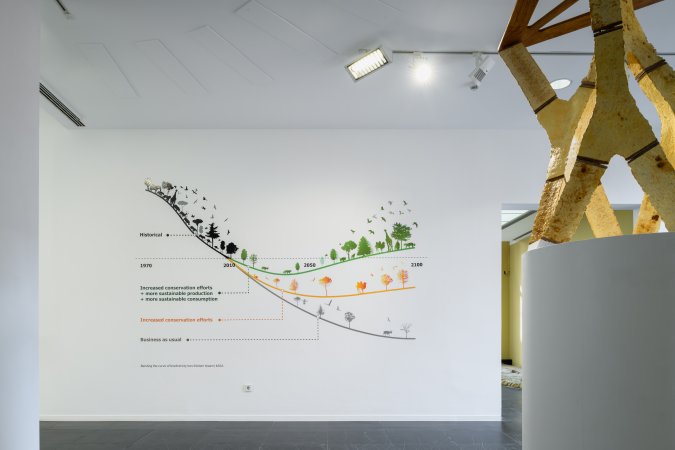International Institute for Applied System Analysis, IIASA
David Leclère et al.
Bending the Curve of Biodiversity Loss, 2020
Infographic from: Leclère D, Obersteiner M, Barrett M, Butchart SHM, Chaudhary A, De Palma A, DeClerck FAJ, Di Marco M, et al. (2020). Bending the curve of terrestrial biodiversity needs an integrated strategy.
Courtesy Adam Islaam | IIASA
Plant and animal species across the world are steadily disappearing due to human activity. According to a major IIASA-led study, turning the tide of biodiversity loss by 2050 or earlier will not be possible without ambitious, integrated action that combines conservation and restoration efforts with a transformation of the food system. The study was a milestone in the use of models and scenarios to explore potential futures for biodiversity, with the results providing key information to the design of the Kunming-Montreal Global Biodiversity Framework adopted at the end of 2022. Such methods can be further employed to shed light on what fair action towards climate, biodiversity and human development goals might look like.
Biodiversity – the variety and abundance of species, along with the extent and quality of the ecosystems they call home – has been declining at an alarming rate for many years. Clearly, we cannot allow the current trend to continue. If it does, there will simply not be enough nature left to support future generations. While ambitious targets have been proposed, practical issues such as feeding the Earth’s growing human population could make achieving such targets an insuperable challenge.
The study was published in Nature and provided input to the 2020 and 2022 World Wide Fund for Nature (WWF) Living Planet Reports. For the first time it set out to explore biodiversity targets as ambitious as a reversal in global biodiversity trends and to shed light on what integrated future pathways to achieving this goal might entail.
The authors wanted to assess in a realistic manner whether it might be feasible to bend the curve of declining terrestrial biodiversity due to current and future land use, while avoiding jeopardizing our chances to achieve other Sustainable Development Goals (SDGs). If this were indeed possible, they also wanted to explore how to get there and what type of actions would be required. The idea was also to examine combining various types of actions that might reduce trade-offs among objectives and instead exploit synergies.
Using multiple models and newly developed scenarios to explore how addressing these elements when integrated might help reach biodiversity targets, the study provided key information on pathways that could materialize the 2050 vision of the UN Convention on Biological Diversity – “Living in harmony with nature”. For global trends of terrestrial biodiversity as affected by land use change to stop declining and start recovering by 2050 or earlier, the researchers highlighted that action is needed in two key areas:
- Bold conservation and restoration efforts together with increased management effectiveness will have to rapidly be stepped up. The study assumes that protected areas quickly reach 40% of global terrestrial areas. This should happen in tandem with major efforts to restore degraded land (reaching about 8% of terrestrial areas by 2050 in the study scenarios) and land use planning measures that balance production and conservation objectives on all managed land. Without such efforts, declines in biodiversity may only be slowed down rather than halted and any potential recovery would remain slow.
- Food system transformation: As bold conservation and restoration efforts alone will likely be insufficient, additional measures are needed to address global pressures on the food system. Efforts to bend the curve of global terrestrial biodiversity include reduced food waste, diets that have a lower environmental impact, and further sustainable intensification and trade.
Integrated action would however need to be taken in both areas simultaneously to effectively bend the biodiversity loss curve upward by 2050 or earlier.
The results showed that in a scenario with increased conservation and restoration efforts alone, almost half of biodiversity losses estimated in the counterfactual business-as-usual scenario could not be avoided; moreover, a bending was not observed for all models, and when it did occur, it was often only in the second half of the 21st century. In addition, the study found that bold conservation and restoration efforts alone might even increase the price of food products, thereby potentially hampering future progress on eliminating hunger.
Conversely, scenarios that combined increased conservation and restoration efforts with efforts to transform the food system showed that opportunities for ambitious conservation and restoration efforts were greater, and potential adverse food security impacts defused, thereby securing a bending of global trends in global terrestrial biodiversity as affected by land use change by 2050. Finally, such transformative change in food and land use systems would also deliver significant co-benefits. These include a major contribution to ambitious climate mitigation targets, reduced pressure on water resources, reduced excess of reactive nitrogen in the environment, and health benefits.
The study further pointed out that unmitigated, emerging threats to biodiversity such as climate change and biological invasions may become as important in the future as land-use change – the largest biodiversity threat to date. A true bending of biodiversity losses will necessitate ambitious climate change mitigation that exploits synergies with biodiversity, rather than further eroding biodiversity.
The landmark paper’s results are reflected in the recently adopted Kunming-Montreal Global Biodiversity Framework, a multilateral agreement crystalizing internationally agreed outcome and action targets to bend the curve of biodiversity loss within the coming decades. Much scientific work is needed, however, to support its successful implementation, along with the goals of the United Nations Framework Convention on Climate Change’s Paris Agreement.
A key topic to unlock the transformative change required by these two agreements is the equitable distribution of efforts in the transition to a nature-positive future. Developed nations, which are responsible for a significant portion of historical greenhouse gas emissions and nature degradation, and have greater resources, should, according to equity principles, make proportionately larger contributions to climate and biodiversity action and funding gaps. Securing the recognition and inclusion of marginalized actors, such as indigenous people and local communities, will be instrumental in achieving a fair transition.
In the pursuit of sustainability, it is important to consider both positive and negative impacts on people’s lives and livelihoods. The focus must be on reducing existing inequalities and injustices. Achieving this requires acknowledging the values, rights, and interests of all individuals, shifting towards rights-based governance, ensuring inclusive representation, and systematically assessing how actions distribute costs and benefits among different actors. Models and scenarios can prove instrumental in such an exploration of alternative futures for nature and people.
Overall, the Bending the Curve of Biodiversity Loss study showed that the world may still be able to stabilize and reverse the loss of nature. But to have any chance of doing that as early as possible we will need to make fair and transformational changes in the way we produce and consume food as well as bolder, more ambitious conservation efforts. If we do not do this, and just continue with business as usual, we will end up with a planet unable to support current and future generations of people.
Reference: Leclere D, Obersteiner M, Barrett M, Butchart SHM, Chaudhary A, De Palma A, DeClerck FAJ, Di Marco M, et al. (2020). Bending the curve of terrestrial biodiversity needs an integrated strategy. Nature DOI: 10.1038/s41586-020-2705-y





